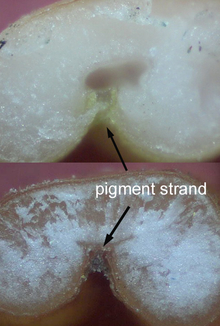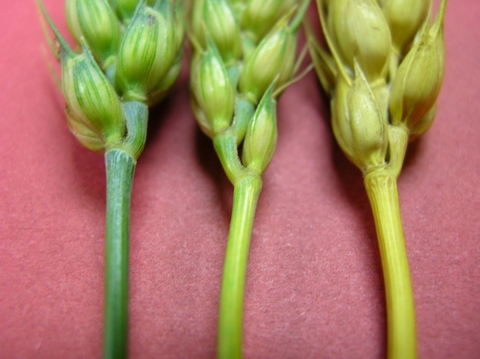There are two methods of pre-harvest management that can speed up the wheat harvest: Swathing or applying glyphosate.
Swathing vs. applying glyphosate
Swathing, or windrowing, once was the default operation that signaled the beginning of harvest. Crop producers do this to speed up and even out crop dry-down. However, there’s a risk with swathing. If adverse weather delays threshing, grain in the swath is more prone to pre-harvest sprouting.
A second pre-harvest option is applying glyphosate at the hard dough stage. Research has shown that glyphosate applied with or without ammonium sulfate may hasten wheat crop dry-down if there are adverse dry-down conditions. With a seven-day pre-harvest interval, you can gain a couple days at the most.
Because modern varieties allow for it, most wheat and barley is now straight-cut instead of swathed. Table 1 summarizes the advantages and disadvantages of pre-harvest glyphosate and swathing.
Table 1 compares the two pre-harvest management methods for wheat.
Table 1: Advantages and disadvantages of each method
Method
Pre-harvest glyphosate
Advantages
-
Fast operation.
-
Faster and more even ripening compared to untreated standing grain.
-
Standing crop will dry faster after a rain than grain in a swath.
-
Opportunity to control weeds.
Disadvantages
-
Poorer weed control of large perennial weeds, compared to post-harvest weed control.
-
Potential for herbicide drift onto other crops.
Swathing
-
Less susceptible to hail damage.
-
More and faster ripening and drying compared to straight-cutting grain.
-
Additional pass through the field.
-
Sprouting damage more likely if swaths are heavy and rain or heavy dew persists.
When to begin pre-harvest management
The optimum time for pre-harvest management is right at or just after the crop reaches physiological maturity (PM). This applies regardless of whether you swath the grain or apply glyphosate as a pre-harvest treatment.
At physiological maturity, the crop has the maximum kernel dry weight. No additional dry matter will be deposited into the grain. Similarly, you can’t increase grain protein after PM through glyphosate applications or other management practices.
The kernel moisture percentage at physiological maturity is relatively high, and can vary from 20 to 40 percent. Research has shown that swathing just before PM doesn’t harm grain yield or quality. However, this practice isn’t recommended when using glyphosate as a pre-harvest tool.
There are two visual indicators you can use to determine whether the crop has reached physiological maturity.
Loss of green from the kernel
The first indicator is the loss of green in the kernel, and the appearance of a dark layer of cells or pigment along the crease (Figure 1). Kernels in the same spike will reach physiological maturity at different times, with the middle of the head maturing first.
Loss of green from the internode or peduncle
Another visual indicator is the loss of green from the uppermost internode or peduncle.
The uppermost portion of the peduncle, just below the spike, will have turned very light green or yellow at physiological maturity (Figure 2). At this time, the transportation of water and nutrients to the head has been cut off and the crop has reached maximum grain fill.
Before physiological maturity
Swathing or applying glyphosate before the crop reaches physiological maturity will result in:
-
Yield losses.
-
Test weight losses.
-
Green kernels in the harvested grains.
Losses get progressively worse the earlier the crop is cut or treated. Research at North Dakota State University (NDSU) in spring wheat and durum showed that swathing the grain at 45 percent moisture caused a 1 to 2 pound reduction in test weight and about a 10 percent reduction in grain yield.
After physiological maturity
Swathing after physiological maturity will result in:
-
Increased risk of shattering.
-
Yield losses.
However, swathing too late doesn’t lead to grain quality losses.
You can reduce shattering losses by swathing in the early morning or late evening, when some dew is on the crop.
Varietal differences in pre-harvest sprouting
Hard red spring wheat (HRSW) varieties differ in their resistance to pre-harvest sprouting, which can be a concern for swathed grain during adverse weather conditions. This high-temperature dormancy peaks at physiological maturity.
Repeated wetting and drying of the grain in a swath, or even while standing, will degrade this dormancy over time. In addition, the dormancy of some varieties break down sooner than others, potentially resulting in sprout damage. View pre-harvest sprouting ratings for current HRSW varieties.
To avoid pre-harvest spring damage, the best remedy is to harvest in a timely manner, even if the grain moisture content is above 13.5 percent.
Reviewed in 2018



